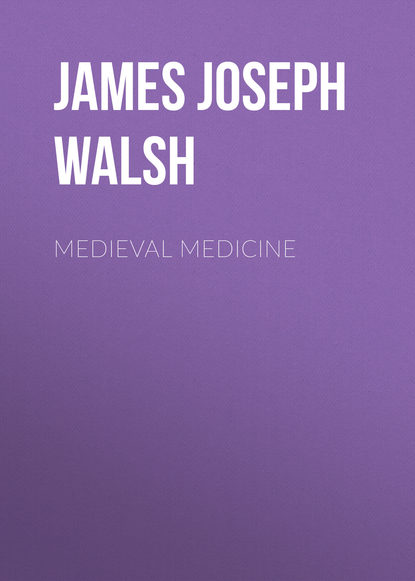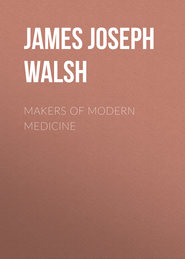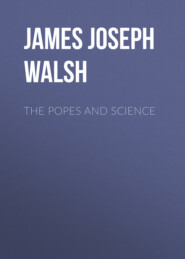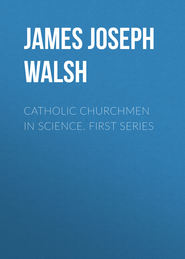По всем вопросам обращайтесь на: info@litportal.ru
(©) 2003-2024.
✖
Medieval Medicine
Настройки чтения
Размер шрифта
Высота строк
Поля
The most interesting feature of the work of the North Italian surgeons of the later Middle Ages is their discovery and development of the two special advances of our modern surgery in which we are inclined to take most pride. These are, union by first intention, and anæsthesia. It is of course very startling to think that surgeons of seven centuries ago should have made advances in these important phases of surgery—which were afterwards to be forgotten; but human history is not a story of constant progress, but of ups and downs, and the mystery of human history is the decadence that almost inevitably follows any period of supremely great accomplishment by mankind. The later Middle Age enjoyed a particularly great period of efflorescence and achievement in surgery, and this, quite as with literature and other phases of human accomplishment, was followed by distinct descent of interest in surgical theory, and decadence in surgical practice, until the Renaissance came to provide another climax of surgical development. It would be perilous to say, however, that the acme of the curve of Renaissance surgical progress was higher than its predecessor, though once more there is the surprise to find that this high point was followed by another descent, until the curve ascended again in our time.
What we have said already with regard to the requirement of cleanliness in operating upon the skull, insisted upon by the Salernitan School, will suggest that some of the practical value of asepsis had come home to these old-time surgeons. The North Italian surgeons went, however, much farther in their anticipations of asepsis. They insisted that if a surgeon made a wound through an unbroken surface and did not secure union by first intention, it was usually his own fault.
It is to them we owe the expression “union by first intention”—unio per primam intentionem—which means nothing to us except through its Latin equivalent. They boasted of getting linear cicatrices which could scarcely be seen, and evidently their practice fostered the best of surgical technique and was founded on excellent principles. The North Italian surgeons replaced the use of ointments by wine, and evidently realized its cleansing—that is, antiseptic—quality. What is often not realized is, that the very old traditional treatment of wounds by the pouring of wine and oil into them represented a mild antiseptic and a soothing protective dressing. The wine inhibited the growth of ordinary germs, the oil protected the wound from dust and dirt. They were not ideal materials for the purpose, but they were much better when discreetly used than many surgical dressings of much more modern times founded on elaborate theories.
Professor Clifford Allbutt, reviewing the practice of these North Italian surgeons of the thirteenth century, says:[9 - “Historical Relations of Medicine and Surgery down to the Sixteenth Century.” London, 1904.]
“They washed the wound with wine, scrupulously removing every foreign particle; then they brought the edges together, not allowing wine nor anything else to remain within—dry adhesive surfaces were their desire. Nature, they said, produces the means of union in a viscous exudation—or natural balm, as it was afterwards called by Paracelsus, Paré, and Wurtz. In older wounds they did their best to obtain union by cleansing, desiccation, and refreshing of the edges. Upon the outer surface they laid only lint steeped in wine. Powder they regarded as too desiccating, for powder shuts in decomposing matters; wine, after washing, purifying, and drying the raw surfaces, evaporates.”
Theodoric wrote in 1266 on that question that so much disturbed the surgeons of the generations before ours, as to whether pus was a natural development in the healing of wounds or not. While laudable pus was for centuries after his time supposedly a scientific doctrine, Theodoric did not think so, and emphatically insisted that such teaching represented a great error. He said: “For it is not necessary, as Roger and Roland have written, as many of their disciples teach, and as all modern surgeons profess, that pus should be generated in wounds. No error can be greater than this. Such a practice is indeed to hinder nature, to prolong the disease, and to prevent the conglutination and consolidation of the wound.” The italics in the word modern are mine, but the whole expression might well have been used by some early advocate of antisepsis, or even by Lord Lister himself. Just six centuries almost to the year would separate the two declarations, yet they would be just as true at one time as at another. When we learn that Theodoric was proud of the beautiful cicatrices which his father had obtained without the use of any ointment—pulcherrimas cicatrices sine unguento inducebat—then, further, that he impugned the use of poultices and of oils in wounds, while powders were too drying, and besides had a tendency to prevent drainage (the literal meaning of the Latin words he employs, saniem incarcerare, is to “incarcerate sanious material”), it is easy to understand that the claim that antiseptic surgery was anticipated six centuries ago is no exaggeration and no far-fetched explanation, with modern ideas in mind, of certain clever modes of dressing hit upon accidentally by medieval surgeons.
After Bruno, who brought with him the methods and principles of surgery from the South of Italy, his contemporary of the North, Hugh of Lucca—Ugo da Lucca, or Luccanus, as he is also called—deserves to be mentioned. He was called to Bologna in 1214 as City Physician, and was with the regiment of crusaders from Bologna at Damietta in 1220. He returned to Bologna in 1221 and occupied the post of legal physician. The Civic Statutes of Bologna are, according to Gurlt, the oldest monument of legal medicine in the Middle Ages. Hugh seems to have been deeply intent on chemical experiments, and especially anodyne and anæsthetic drugs. He is said to have been the first to have taught the sublimation of arsenic. Like many another distinguished practitioner of medicine and surgery, he left no writings. All that we know of him and his work, and above all his technique, we owe to the filial devotion of his son Theodoric.
Anæsthesia is perhaps an even greater surprise in the Middle Ages than practical antisepsis. A great many of these surgeons of the time seem to have experimented with substances that might produce anæsthesia. Mandragora was the base of most of these anæsthetics, though a combination with opium seems to have been a favourite. They succeeded apparently, even with such crude means, in producing insensibility to pain without very serious dangers. One of these methods of Da Lucca was by inhalation, and seems to have been in use for a full century. Guy de Chauliac describes the method as it was used in his day, and a paragraph with regard to it will be found in the chapter on Surgeons of the West of Europe. It is quite clear that the extensive operations which are described in their textbooks of surgery at this time could not possibly have been performed, only that the surgeons were able to secure rather a deep and prolonged insensibility to pain. With anæsthesia combined with antisepsis, it is easy to understand how well equipped the surgeons of this time were for the development of their speciality.
The fourth of these great surgeons at the North of Italy was William of Salicet. He was a pupil of Bruno of Longoburgo. Some idea of his practice as a surgeon may be obtained from even the first chapter of his first book. He begins with the treatment of hydrocephalus—or, as he calls it, “water collected in the heads of children newly born.” He rejects opening of the head by incision because of the danger of it. He had successfully treated some of these difficult cases, however, by puncturing the scalp and membrane by a cautery, a very small opening being made and fluid being allowed to escape only drop by drop. William did not quote his predecessors much, but depended to a great extent on his own experience. He has many interesting details of technique with regard to the special subject of surgery of the nose, the ear, the mouth; and he did not even hesitate to treat goitre when it grows large, and says that if the sac is allowed to remain it should be thoroughly rubbed over on the inside with “green ointment.” He warned “that in this affection many large bloodvessels make their appearance, and they find their way everywhere through the fleshy mass.”
A very interesting development of surgery along a line where it would probably be least expected was in plastic surgery. In the first half of the fifteenth century the two Brancas, father and son, performed a series of successful operations for the restoration of the nose particularly, and the son invented a series of similar procedures for the restoration of mutilated lips and ears. The father seems to have built up the nose from other portions of the face, possibly using, as Gurlt suggests, the skin of the forehead, as the Indian surgeons had done, though without any known hint of their work. Fazio, the historian of King Alphonso I. of Naples, who died in 1457, describes the favourite operation of Antonio Branca, the son, who in order not to disfigure any further the face in these cases, made the new nose from the skin of the upper arm; and in anticipation of Tagliacozzi, who attracted much attention by a similar operation in the latter half of the sixteenth century, separated the new nose from the arm sometime during the third week. There is abundance of other evidence as to the Brancas’ work from contemporary writers—for instance, Bishop Peter Ranzano the annalist, the poet Calenzio, and Alexander Benedetti, the physician and anatomist—so that there can be no doubt of the fact that this wonderful invention in surgical technique was actually made before the close of the Middle Ages.
It is interesting to realize that, while we hear much about the work of the Brancas, and from ecclesiastical authorities, there is no word of condemnation of the practice of restoring the nose or other facial features until much later in history. Tagliacozzi, who revived the operation of rhinoplasty just about the beginning of the seventeenth century, did not share so kind a fate. The latter Italian surgeon was roundly abused by some of his colleagues, even, it is said, by Fallopius and Paré, and bitterly satirized in Butler’s “Hudibras.” As late as 1788 (!) the Paris faculty interdicted face-repairing altogether. It is this sort of intolerance, on some superstitious ground or other, that is usually attributed to the Middle Ages. For such events the adjective medieval seems particularly adapted. As a matter of fact, we find comparatively little trace of such intolerance in medieval times; but it is comparatively easy to find the bitterest treatment of fellow-mortals for all sorts of foolish reasons in the seventeenth and eighteenth centuries.
CHAPTER VII
SURGEONS OUTSIDE OF ITALY: SURGEONS OF THE WEST OF EUROPE
“Sciences are made by addition, and it is not possible that the same man should begin and finish them....” “We are like infants at the neck of a giant, for we can see all that the giant sees and something more.”—(Guy De Chauliac, Papal Physician to the Popes at Avignon.)
The very interesting and in many ways astonishing development of surgery which occurred in Italy in the twelfth and thirteenth centuries, was followed up by similar developments in the western countries of Europe. France was the first to fall into the line of progress with important advances in surgery, and owes her teaching directly to the Italians; but in Flanders, in England, in Spain, and in Germany, we have records of some significant advances in surgery, and distinguished surgeons wrote books that fortunately for the history of surgery were preserved. The most important of the surgical writings of the time, put in type during the great nascent period of printing at the Renaissance, have come down to us. Many of these have been republished in recent years, and as the texts are now readily available they enable anyone to see for himself just what were the interests of the surgeons of the later medieval period, their technique, and their successful applications of great practical principles to the solution of important surgical problems.
The beginning of French scientific surgery came with the exile from Italy of Lanfranc, as he is known, though his Italian name was Lanfranchi or Lanfranco, and he is sometimes spoken of as Alanfrancus. He had practised as physician and surgeon in Milan until banished from there by Matteo Visconti, about 1290. He made his way then to Lyons, where he attracted so much attention by his success as a surgeon that he was offered the chair of professor of surgery at the University of Paris. “He attracted an almost incredible number of scholars to his lessons in Paris, and by hundreds literally they accompanied him to the bedside of his patient and attended his operations” (Gurlt). Paris was at this time at the very height of its glory as a University. It had had a series of distinguished professors whose writings are still known and honoured, Albert the Great, Thomas Aquinas, Roger Bacon, and Duns Scotus; and during the latter half of the thirteenth century Louis IX. had encouraged the University in every way, and had helped in the foundation of the Sorbonne. There were probably more students in attendance at the University of Paris about the time that Lanfranc was there than there has ever been in attendance at any University before or since. The prestige of Lanfranc’s position, then, and his opportunity to impress the world of his time, can be readily appreciated.
The Dean of the medical faculty of Paris, Jean de Passavant, urged Lanfranc to write a textbook of surgery, partly for the familiar academic reason that the students were clamouring for some definite record of his teaching, but also because the Dean felt that the many copies of these lessons which the students would take away with them, and which would be consulted by others, would add greatly to the prestige of the medical school. Medical school officials are not so different after more than six and a half centuries. Lanfranc completed his textbook of surgery, called “Chirurgia Magna,” in 1296, and dedicated it to Philippe le Bel, the then reigning King of France. It is from this work that we are able to judge exactly what the value of Lanfranc’s surgical teaching was.
In the second chapter of his textbook—the first containing the definition of surgery and a general introduction—Lanfranc devotes some paragraphs to the surgeon himself, and the qualities that a surgeon should possess if he is to be successful in his speciality. It is about the sort of advice that older surgeons are still likely to give young men who are entering on the practice of the speciality, and more or less what is said at many a commencement in the modern time when the maker of the address to the graduates is a surgeon.
“It is necessary that a surgeon should have a temperate and moderate disposition. That he should have well-formed hands, long slender fingers, a strong body, not inclined to tremble, and with all his members trained to the capable fulfilment of the wishes of his mind. He should be well grounded in natural science, and should know not only medicine but every part of philosophy; should know logic well, so as to be able to understand what is written; to talk properly, and to support what he has to say by good reasons.” He suggests that it would be well for the surgeon to have spent some time teaching grammar and dialectics and rhetoric, especially if he is to teach others in surgery, for this practice will add greatly to his teaching power. (What a desideratum for the modern time is thus outlined!) Some of his expressions might well be repeated to young surgeons in the modern time. “The surgeon should not love difficult cases, and should not allow himself to be tempted to undertake those that are desperate. He should help the poor as far as he can, but he should not hesitate to ask for good fees from the rich.”
Lanfranc was himself a scholar well read in the literature of his profession, but who had well digested his reading. He quotes altogether more than a score of writers on surgery who had preceded him, and evidently was thoroughly familiar with general surgical literature. He is a particular favourite of Gurlt, the German historian of surgery, who has devoted more than twenty-five closely printed large octavo pages to the discussion of this old Paris professor and his work. Lanfranc’s discussion of wounds of nerves is of itself sufficient to show the character of his work. Many generations after his time have used the word nerves for tendons, and mistaken the function of these two structures, but Lanfranc distinguished very clearly between them. He declared that since the nerves are instruments of sense and motion, wounds of them should be carefully treated, especially as the sensitiveness of these structures is likely to cause the patient much subsequent pain if they are neglected. Longitudinal wounds of nerves are much less dangerous than those across them. When a nerve is completely divided in cross section Lanfranc was of the opinion, though Theodoric and some others were opposed to it, that the nerve ends should be stitched together. He says that the suture insures the reintegration of the nerve much better. Besides, after this operation the restoration of the usefulness of the member is more assured and is commonly more complete.
After Lanfranc at Paris came Henri de Mondeville, whom Latin writers usually quote as Henricus. At least a dozen variants of the second portion of his name are found in literature, from Armondeville to Hermondaville. He was another of the University men of this time who wandered far for opportunities in education. Though born in the North of France and receiving his preliminary education there, he made his medical studies in the latter half of the thirteenth century under Theodoric in Italy. Afterwards he studied medicine in Montpellier and surgery in Paris. Later he gave at least one course of lectures at Montpellier, and then a series of lectures in Paris, attracting to both universities during his professorship a crowd of students from every part of Europe. One of his teachers at Paris had been his compatriot, Jean Pitard, the surgeon of Philippe le Bel, of whom he speaks as “most skilful and expert in the practice of surgery,” and it was doubtless to Pitard’s friendship that he owed his appointment as one of the four surgeons and three physicians who accompanied the King into Flanders.
There is an historical tradition which has led many to believe that the surgery of the fourteenth century was mainly in the hands of the barber surgeons—ignorant men who plied a rude handicraft in connection with some conventional use of the lancet—and that the physicians quite despised their surgical colleagues. Mondeville is a striking contradiction of this. He was a scholarly man, who quotes not only all the distinguished contributors to medicine and surgery before his time, the Greeks and Latins, the Arabs, and his Italian masters, but who also has quotations from poets and philosophers, Aristotle, Plato, Diogenes, Cato, Horace, Ovid, Seneca, and others.
The Regius Professors of Medicine at both Oxford and Cambridge in our generation are on record with the declaration that medicine and surgery have been allowed to drift too far apart, and that above all the physician should see more of surgical operations for the confirmation of diagnoses, for they are real bioscopys. It is rather interesting to find, then, that Mondeville felt the necessity in his time for close relations between physicians and surgeons, and said:
“It is impossible that a surgeon should be expert who does not know not only the principles, but everything worth while knowing about medicine,” and then he added, “just as it is impossible for a man to be a good physician who is entirely ignorant of the art of surgery.” He says further: “This our art of surgery, which is the third part of medicine [the other two parts were diet and drugs] is, with all due deference to physicians, considered by us surgeons ourselves and by the non-medical as a more certain, nobler, securer, more perfect, more necessary, and more lucrative art than the other parts of medicine.” Surgeons have always been prone to glory in their speciality.
Mondeville is particularly interesting for the history of surgery because he himself ventured to trace some of the recent history of the development of his speciality. Following Galen’s example, who had divided the physicians of the world into three sects, the Methodists, the Empirics, and the Rationalists, Mondeville divides modern surgery into three sects: First, that of the Salernitans, with Roger, Roland, and the Four Masters; second, that of William of Salicet, and Lanfranc; and third, that of Ugo da Lucca and his son Theodoric and their modern [sic] disciples.
The characteristics of these three sects are in brief. The first limited patients’ diet, used no stimulants, dilated all wounds and looked for union only after pus formation. The second allowed a liberal diet to weak patients, though not to the strong, but generally interfered with wounds too much. The third believed in a liberal diet, never dilated wounds, never inserted tents, and its members were extremely careful not to complicate wounds of the head by unwise interference. Almost needless to say, his critical discussion of the three schools is extremely interesting.
Mondeville was himself a broadly educated scholar, who considered that the surgeon should know everything worth while knowing about medicine, for his work was greater than that of the physician. While he had high ideas, however, of the value of theoretic knowledge, he insisted above all on the value of practical training. He said, in his textbook on surgery, as to what the training of the surgeon should be:
“A surgeon who wishes to operate regularly ought first for a long time to frequent places in which skilled surgeons often operate, and he ought to pay careful attention to their operations and commit their technique to memory. Then he ought to associate himself with them in doing operations. A man cannot be a good surgeon unless he knows both the art and science of medicine, and especially anatomy. The characteristics of a good surgeon are that he should be moderately bold, not given to disputations before those who do not know medicine, operate with foresight and wisdom, not beginning dangerous operations until he has provided himself with everything necessary for lessening the danger. He should have well-shaped members, especially hands with long slender fingers, mobile and not tremulous, and with all his members strong and healthy, so that he may perform all the proper operations without disturbance of mind. He must be highly moral, should care for the poor for God’s sake, see that he makes himself well paid by the rich, should comfort his patients by pleasant discourse, and should always accede to their requests if these do not interfere with the cure of the disease.” “It follows from this,” he says, “that the perfect surgeon is more than the perfect physician, and that while he must know medicine he must in addition know his handicraft.”
The other great French surgeon of the fourteenth century was Guy de Chauliac, who well deserves the name of father of modern surgery. He was educated in a little town in the South of France, made his medical studies at Montpellier, and then went on a journey of hundreds of miles to Italy in order to make his postgraduate studies. While it is not generally realized, for some seven centuries before the nineteenth Italy was the home of graduate teaching in all departments. Whenever a man in any country in Europe, from the beginning of the twelfth until the end of the eighteenth century, wanted to secure opportunities for the higher education that were not available in his home country, he went down into Italy. At the beginning of the nineteenth century France usurped Italy’s place for half a century, and Germany pre-empted the position to a great degree during the latter half of the nineteenth. The journey to Italy in the Middle Ages was more difficult, and involved more expense and time, than would even the voyage from America to Europe in our time; yet many a student from France, Germany, and England made it for the sake of the postgraduate opportunities, and it is matter for professional pride that this was particularly true of our medieval colleagues in medicine and surgery.
Larger Image
SURGICAL INSTRUMENTS OF GUY DE CHAULIAC, NOS. 1, 2, 3, AND 4 (FOURTEENTH CENTURY);
AND SURGICAL APPARATUS OF HANS VON GERSSDORFF, NOS. 5, 6 AND 7 (FIFTEENTH CENTURY)
After plates in Gurlt’s “Geschichte der Chirurgie”
To know Guy de Chauliac’s works well is to have ready contradictions at hand to practically all of the objections so frequently repeated as to the lack of scholarly work during the Middle Ages. For instance, Guy de Chauliac insisted on the value of experience rather than authority, and of original work rather than mere copying. He criticized in bitter satire John of Gaddesden’s book on medicine, called after the fashion of the time by the poetical title “Rosa Anglica,” of which he said: “Last of all bloomed the scentless Rose of England, which on its being sent to me I hoped to find bearing the odour of sweet originality. But instead of that I encountered only the fictions of Hispanus, of Gilbert, and of Theodoric.” His mode of satirical expression is all the more interesting and significant, because it shows that the men of the time were critically minded enough as regards many of the passages in the writings of their predecessors with which fault has been found in the modern time, though we have usually been inclined to think that medieval readers accepted them quite uncritically. Chauliac’s bitterest reproach for many of his predecessors was that “they follow one another like cranes, whether for love or fear I cannot say.”
Chauliac’s description of the methods of anæsthesia practised by the surgeons of his time, especially in cases of amputation, is particularly interesting to us because the anæsthetic was administered by inhalation. Chauliac says:
“Some surgeons prescribe medicaments, such as opium, the juice of the morel, hyoscyamus, mandrake, ivy, hemlock, lettuce, which send the patient to sleep, so that the incision may not be felt. A new sponge is soaked by them in the juice of these and left to dry in the sun; when they have need of it they put this sponge into warm water, and then hold it under the nostrils of the patient until he goes to sleep. Then they perform the operation.”[10 - The subsequent disuse of anæthesia seems an almost impossible mystery to many, but the practically total oblivion into which the practice fell is incomprehensible. This is emphasized by the fact that while it dropped out of medical tradition, the memory of it remained among the poets, and especially among the dramatists. Shakespeare used the tradition in “Romeo and Juliet.” Tom Middleton, in the tragedy of “Women Beware Women” (Act IV., Scene i., 1605), says:]
Chauliac was particularly interested in the radical cure of hernia, and he discusses six different operations for this purpose. Gurlt points out that Chauliac’s criticism of these operations is quite modern in its viewpoint. He declared that practically the object of radical operations for hernia is to produce a strong, firm tissue support over the ring through which the cord passes, so that the intestines cannot descend through it. It is rather interesting to find that the surgeons of this time tried to obliterate the canal by means of the cautery, or inflammation-producing agents—arsenic and the like—a practice that recalls some methods still used more or less irregularly. They also used gold wire as a support; it was to be left in the tissues, and was supposed to protect and strengthen the closure of the ring. At this time all these operations for the radical cure of hernia involved the sacrifice of the testicle, because the old surgeons wanted to obliterate the ring completely, and thought this the easiest way. Chauliac criticizes the operation in this respect, but says that he has “seen many cases in which men possessed of but one testicle have procreated, and this is a problem where the lesser of two evils is to be chosen.”
While he discussed hernia operations so freely, the great French surgeon did not believe that everyone who suffered from a hernia ought to be submitted to an operation. He quite agreed with Mondeville who, in the preceding generation, declared that many operations for hernia were done not for the benefit of the patient but for the benefit of the surgeon—a mode of expression that is likely to strike a sympathetic chord in some physicians’ minds even at the present time. Chauliac’s rule was that no operation should be attempted unless the patient’s life was put in danger by the hernia, but that a truss should be worn to retain it. He emphasized that trusses should not be made according to rule, but must be adapted to each individual, and he invented several forms of trusses himself. He developed the method of taxis by which hernias might be reduced, suggested an exaggerated Trendelenburg position for operations for hernia and for the manipulations necessary for the reduction of hernia.
The technique of some of these old surgeons is a never-ending source for surprise. The exaggerated Trendelenburg position in the operation for the radical cure of hernia—the patient being fastened on an inclined board, head down, so that the intestines would fall away from the site of operation—was used by Guy de Chauliac, who probably obtained a hint of it from Italy. He also employed extension in the treatment of fracture of the thigh, inventing an apparatus by which this might be continued for a long time until the muscles were relaxed from overtiredness. He made use for this purpose of a weight suspended on a cord which ran over rollers. He also adapted stiffened bandages of various kinds, especially employing white of egg for this, and sometimes moulding bandages to the limbs in cases of fracture. Yperman, the Flemish surgeon of this time, knew and used the œsophagus tube for artificial feeding, and a number of various kinds of instruments were invented for the urethra, including bougies of wax, tin, and silver. In diseases of the bladder and in gonorrhœa John Ardern employed astringent injections.
Probably what ought to be considered the most important work of the French surgeons of the Middle Ages has been quite misunderstood until recent years. In his paper on “The Origin of Syphilis,” at the Seventeenth International Congress of Medicine (London, 1913), Professor Karl Südhoff of Leipzig (see Transactions) reviewed the use of mercury in the form of mercurial ointment during the later Middle Ages, and the reputation that it had acquired for the cure of ulcers, skin eruptions of various kinds, and other distinctly objective lesions. It is perfectly clear now that the success of this form of therapy was due to the fact that syphilis was being treated. The French surgeons of the South of France developed the empiric discovery of the value of this remedy, the first hint of which had probably come to them from the Italians. It is one of the few specifics in the history of medicine. Needless to say, it is still with us, and still the accepted medication in spite, as Professor Südhoff notes, of the often-attempted replacement of it down the centuries by some form or other of arsenic treatment, though this has always been afterwards abandoned, and it would seem as though our generation might furnish another instance of the triumph of the medieval mercurial treatment over arsenic.
The real reason then, it would seem, why syphilis came to be called the morbus Gallicus, or French Disease, was because when knowledge of its differential diagnosis was generalized, physicians at the same time learned of the remedy which could be so successfully employed for its treatment, the value of which had been determined as the result of the careful observations of the surgeons of South France. It is probable, as I have said, that the original idea for this form of treatment came from the Italian surgical traditions brought over from Italy by Lanfranc and his contemporaries at the end of the thirteenth century. There can be no doubt at all, however, of the power of clinical observation of the medieval surgeons who gave us this wonderful advance in therapeutics.
The most distinguished pupil of Guy de Chauliac was Pietro d’Argelata, who died about 1423 as a professor at Bologna, but whose textbook, “The Cirurgia,” was among the first of medical books to be printed at Venice in 1480. His teaching was still a living force at that time, and it is evident that he had attracted wide attention in his own generation. He taught the dry treatment of wounds, suggesting various powders to be employed on them, and gave his experience with sutures and drainage tubes in wounds.
Ligatures are often supposed to have been invented much later. They have been attributed to Ambroise Paré and other surgeons of the Renaissance period, but were probably used at many times during the Middle Ages, and had been invented and frequently employed by the Greeks. They invariably went out of use after a time, however, and had to be reinvented. As I said in “Old-Time Makers of Medicine”:
“It is hard to understand how so useful an auxiliary to the surgeon as the ligature—it seems indispensable to us—could possibly be allowed to go out of use and even be forgotten. It will not be difficult, however, for anyone who recalls the conditions that obtained in old-time surgery to understand the succession of events. The ligature is a most satisfying immediate resource in stopping bleeding from an artery, but a septic ligature inevitably causes suppuration, and almost inevitably leads to secondary hæmorrhage. In the old days of septic surgery, secondary hæmorrhage was the surgeon’s greatest and most dreaded bane. Some time from the fifth to the ninth day a septic ligature came away under conditions such that inflammatory disturbance had prevented sealing of the vessel. If the vessel was large, the hæmorrhage was fast and furious, and the patient died in a few minutes. After a surgeon had had a few deaths of this kind he dreaded the ligature.
“Eventually he abandoned its use, and took kindly even to such methods as the actual cautery, red-hot knives for amputations and the like, that would sear the surfaces of tissues, and the bloodvessels, and not give rise to secondary hæmorrhage. A little later, however, someone not familiar with the secondary risks would reinvent the ligature. If he were cleanly in his methods, and, above all, if he were doing his work in a new hospital, the ligature worked very well for a while. If not, it soon fell into innocuous desuetude again. In any case, it was only a question of time until it would be abandoned.”
There was at least one, and probably a number of English surgeons who were doing excellent work in the latter part of the Middle Ages, but John of Ardern wrote a book which has come down to us, and from him we may judge the character of his contemporaries. He was educated at Montpellier, and practised surgery for a time in France. About the middle of the fourteenth century, according to Pagel, he went back to his native land and settled for some twenty years at Newark in Nottinghamshire; and for nearly thirty years longer, until near the end of the century, practised in London. Ardern’s speciality was diseases of the rectum, but he made special studies in the treatment of fistulas everywhere in the body. He was an expert operator, and seems to have had excellent success in this field. He made careful statistics of his cases, and was quite as proud as any modern surgeon of the large numbers that he had operated on, which he gives very exactly. He was the inventor of some new instruments and of a clyster apparatus. We know something also about his fees, and there is no doubt that he obtained quite as good fees in proportion to the value of money as even any specialist of the modern time.
Ardern gives many evidences of his power of clinical observation, and incidentally makes it very clear that the eyes of the men of his time were not so held from seeing the things that lay before them as is often assumed. Mr. D’Arcy Power, in the paper on “The Lesser Writings of John Ardern” which he read before the section on the History of Medicine at the Seventeenth International Congress (see Transactions), has quoted a series of paragraphs from Ardern which make it very clear how accurate an observer this fourteenth-century Englishman was. Here, for instance, is his description of epidemic sore throat in his time, probably diphtheria, for the death within five days through strangling would seem to point to this:
“And note diligently that in the sqwynancy [quinsy] and in all the swellynges of the throte and the nekke and in all the lettynges and swolowynge as whanne the pacient thereof is oftetymys dysposyd to the deeth withinne schort time and I have seye manye deyed thereof within v dayes thorough stranglynge. To the weche it is to know that ther is nothynge more profytablere therefore thane to use glysteryes of malowys, mercurye [cheno-podium?] branne and oyle or buttre, hony and Sal gemme or comone salt. This operacione draweth the wykkyd humours to the inner partyes that causeth the syknesse and so it helpeth the sqwynnancye.”
Ardern’s description of rabies, its fatality, and of how a mad dog acts, exemplifies still further his accuracy of clinical observation. Only one who had seen many cases and understood them, and had had many mad dogs under observation, could have given the details he does. A single paragraph confirms the idea that the medieval surgeons had very clearly recognized the disease, and knew as much about it as was known until our own generation added something of more definite knowledge of the affection than could be gained by mere clinical observation. Ardern says:
“The bytynge of a wood [mad] dogge is more venemous and perilous thane it is of a serpente, ffor the venyme of a wood dogge ys hydd often tymes by the hole yere togydere and other whyle by the ii [two] yere and after some auctours it wole endure vii yere or it sle [slay] a man. And note wheyther it be longe tyme hydd or schorte or that it slee ther comene tofore to the pacient thes tokenys medlynge and chaungynge of wytte and resone and abhominacione and lothsomnesse of cold water that is clene and pure. And whane suche sygnys fallen to him that is byten of a wood hound schall unnethe or ellys [seldom or never] escape it.











